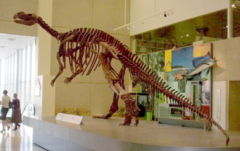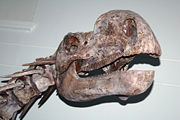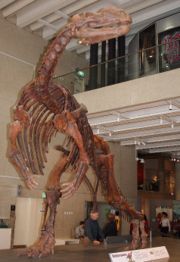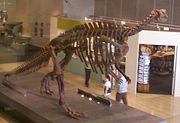Muttaburrasaurus
2008/9 Schools Wikipedia Selection. Related subjects: Dinosaurs
| Muttaburrasaurus Fossil range: Early Cretaceous |
||||||||||||||||
|---|---|---|---|---|---|---|---|---|---|---|---|---|---|---|---|---|
 Muttaburrasaurus skeleton
at the Queensland Museum. |
||||||||||||||||
| Scientific classification | ||||||||||||||||
|
||||||||||||||||
| Species | ||||||||||||||||
|
M. langdoni Bartholomai & Molnar, 1981 ( type) |
Muttaburrasaurus is a genus of herbivorous ornithopod dinosaur related to Camptosaurus and Iguanodon, from what is now northeastern Australia between 100 and 98 million years ago during the early Cretaceous Period. After Minmi, it is Australia's most completely known dinosaur from skeletal remains.
Discovery and species
The species was initially described from a partial skeleton found by Doug Langdon in 1963 near Muttaburra, Queensland, Australia, which also provides the creature's name. It was named in 1981 by Dr Alan Bartholomai and Ralph Molnar, who honoured its discoverer with its specific name langdoni. Some teeth have been discovered further north, near Hughenden and south at Lightning Ridge, in Northwestern New South Wales. A skull, known as the "Dunluce Skull" was discovered by John Stewart-Moore and 14 year old Robert Walker on Dunluce Station, between Hughenden and Richmond in 1987.
Muttaburrasaurus species
- M. langdoni ( type)
Paleobiology
Muttaburrasaurus was capable of either bipedal or quadrupedal movement. The three middle digits of the forelimb were joined together into a hoof-like pad for walking on.
Muttaburrasaurus had very powerful jaws equipped with shearing teeth. These were probably an adaptation for eating tough vegetation such as cycads. It also had an enlarged, hollow, upward-bulging muzzle that might have been used to produce distinctive calls or for display purposes. However, as no fossilised nasal tissue has been found, this remains conjectural.
Muttaburrasaurus was about 7 to 9 meters long and its mass was between 1 and 4 tons. It also had a spiked thumb, which was about 15cm long.
In culture
Reconstructed skeleton casts of Muttaburrasaurus have been put on display at a number of museums, including the Queensland Museum, Flinders Discovery Centre, and National Dinosaur Museum in Australia. Muttaburrasaurus was featured in the fifth episode of the BBC television series Walking with Dinosaurs, and in the 1995 animated film The Land Before Time III: The Time of the Great Giving


